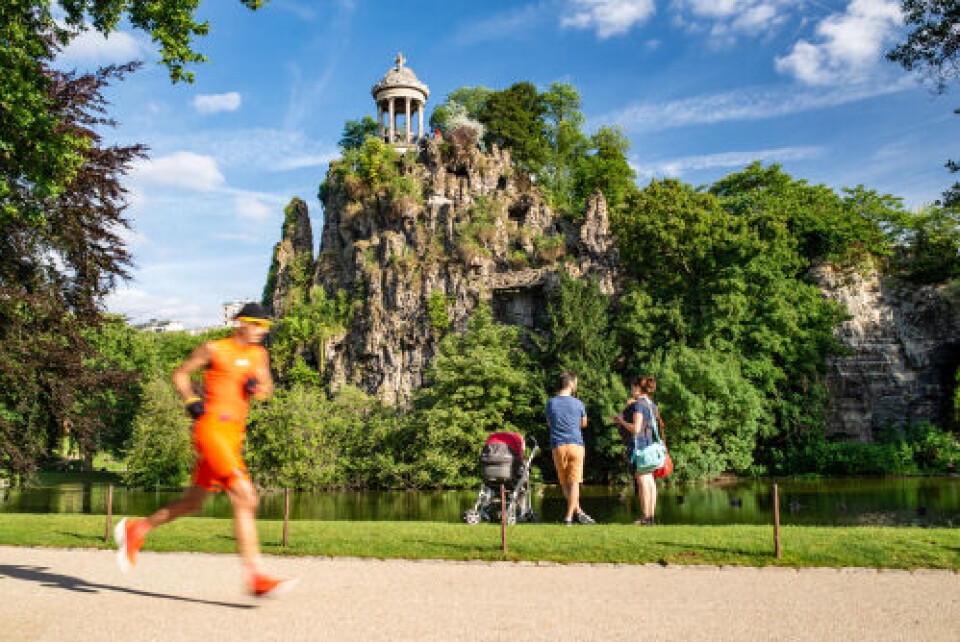-
Price rises for Netflix in France
The Standard (with ads) and Premium packages are increasing by €24 a year
-
Letters: The reality of finding a new doctor or dentist in France
Finding a replacement is nigh impossible, says Connexion reader in Lot-et-Garonne
-
The magic of mayonnaise: Why a homemade emulsion always woos guests in France
Plus, which shop-bought mayo brand is best?
Emily in Paris park ‘shows the two sides of Paris’
Columnist Nabila Ramdani takes a closer look at the Buttes-Chaumont Park, which has recently featured in both the Netflix series and crime reports surrounding a grisly murder case

Idyllic is an overused word, but not when you’re enjoying a sunset picnic on one of the most beautiful hillsides in Paris.
Beyond the romantic follies – there’s a temple and a cascading waterfall by a lake with a bridge across it – you can see the Eiffel Tower and Sacré-Cœur basilica shimmering in the evening light.
The smell of delicacies from a local boulangerie mixes with the fragrance of flowers carried by the light breeze.
The sensory and visual pleasures on offer inside the Buttes-Chaumont park certainly worked for Emily in Paris.
Episode three of the hit Netflix series features the eponymous heroine – played by Lily Collins – and an equally glamorous friend enjoying a bite around the blossoming trees, and viewer numbers went through the roof.
So much so that millions in the US thought: “Yes siree, this is the real Paris, and I want to be a part of it!”
Spike in cross-Atlantic holiday bookings
Cross-Atlantic holiday bookings spiked, as vast amounts of tourist dollars were poured into the Paris economy.
This is the conclusion of a new Ifop poll, which shows that 73% of Americans now have a “very good” or “quite good” image of the French capital, compared to just 39% in 2007.
The change is incredible, and largely attributed to the Emily effect – one that projects a manicured Paris where everyone is wearing designer clothes and Champs-Elysées smiles as they lounge contentedly on eternal lawns that are always dappled in sunshine.
Read more: Netflix’s Emily boosts Americans’ opinion of Paris, poll shows
Chilling murder case
How unfortunate, then, that the Buttes-Chaumont is now at the centre of a chilling murder case that is causing fear and outrage across the city.
Female body parts, including a decapitated head, were found in two waste bags dumped in thick woods and by a disused railway line.
We don’t need to dwell on more gory details to realise that this is a very extreme example of the social problems that plague the park.
Yes, the Buttes-Chaumont is superficially lovely, but aesthetic charms cover up all kinds of grisly antecedents.
The very name means Bald Hill, and it was the place where criminals were once hanged and their bodies left out for public view.
It then became a dump for animal carcasses and sewage, before finally being converted into a public park in the 1860s.
This was a time when the working-class population of the 19th arrondissement in which the park is set was expanding rapidly.
Street crime
Nowadays, the north-east district is firmly associated with street crime, from drug dealing to prostitution.
In this sense, Buttes-Chaumont is a perfect metaphor for Paris itself.
Both invariably look magnificent, thanks mainly to man-made wonders that have impressed visitors from all over the world but which soon start to crumble under any kind of scrutiny.
Park and city have attracted the worst of humanity throughout the centuries, along with the waste products of an expanding urban population in an age of rapid industrialisation.
It is because of such harsh realities that we have popular entertainment to distract us, and – like it or loathe it – Emily in Paris follows in the Hollywood tradition of turning France into an illusion that even the most cynical can get pleasure out of.
Films such as An American in Paris, starring Gene Kelly and Leslie Caron, and Funny Face – Audrey Hepburn and Fred Astaire – were doing exactly the same thing well over half a century ago, and within a few years of Paris being under Nazi occupation.
Lethal horror, dirt and squalor were magicked away, and – as today – love, beauty and a burgeoning tourist industry all benefited.
Related articles
I’m Parisian: Here’s my view on the clichéd vision of Emily in Paris
Meet the woman who inspired Netflix’s 'Emily in Paris'
























